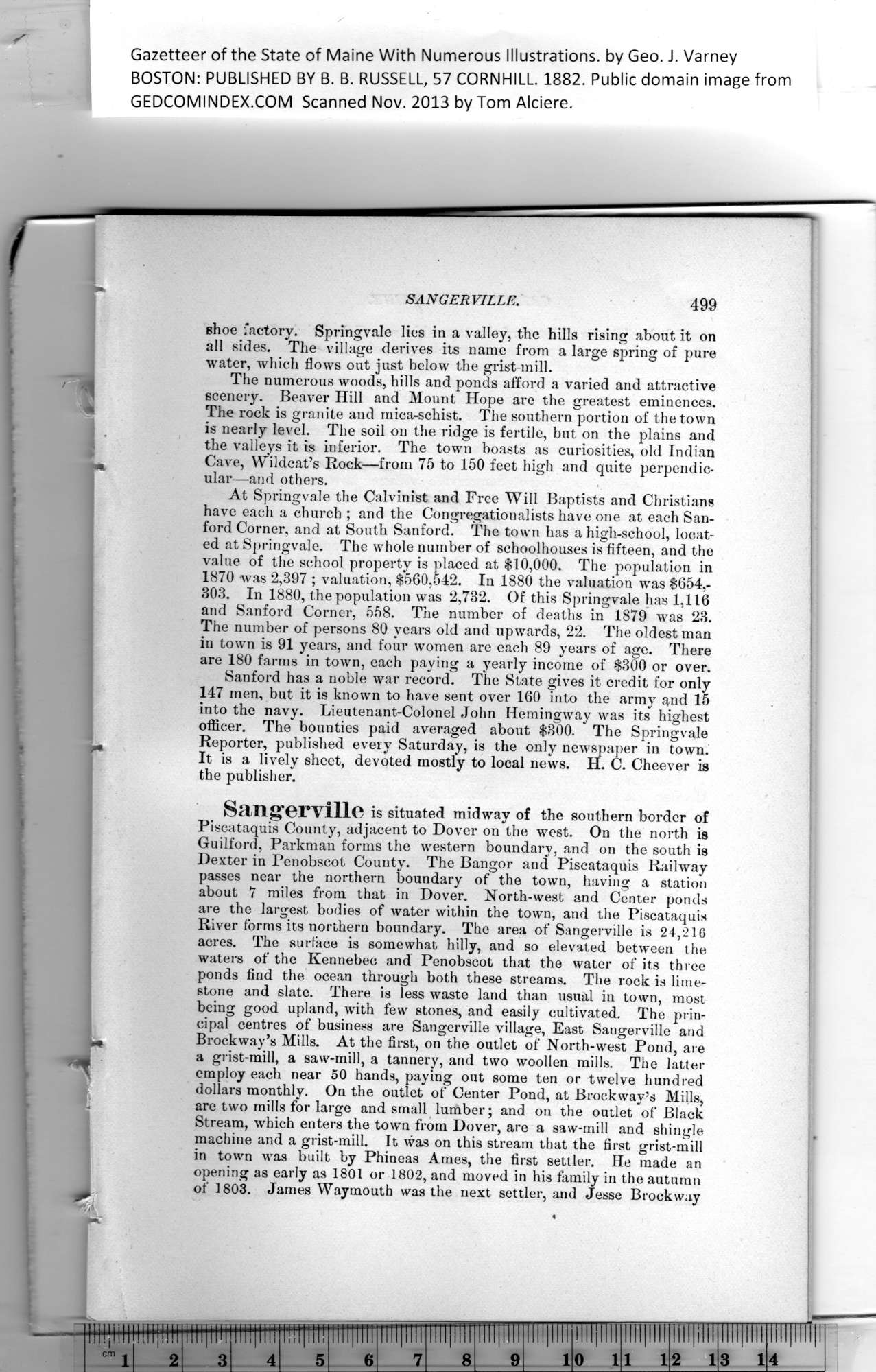|
Gazetteer of the State of Maine With Numerous Illustrations, by Geo. J. Varney
BOSTON: PUBLISHED BY B. B. RUSSELL, 57 CORNHILL. 1882. Public domain image from
SANGERVILLE. 499
shoe factory. Springvale lies in a valley, the hills rising about it on
all sides. The village derives its name from a large sjiring of pure
water, which flows out just below the grist-mill.
The numerous woods, hills and ponds afford a varied and attractive
scenery. Beaver Hill and Mount Hope are the greatest eminences.
The rock is granite and mica-schist. The southern portion of the town
is nearly level. The soil on the ridge is fertile, but on the plains and
the valleys it is inferior. The town boasts as curiosities, old Indian
Cave, Wildcat’s Rock—from 75 to 150 feet high and quite perpendic-
ular—and others.
At Springvale the Calvinist and Free Will Baptists and Christians
have each a church ; and the Congregationalists have one at each San-
ford Corner, and at South Sanford. The town has a high-school, locat-
ed at Springvale. The whole number of schoolhouses is fifteen, and the
value of the school property is placed at $10,000. The population in
1870 was 2,397 ; valuation, $560,542. In 1880 the valuation was $654,-
303. In 1880, the population was 2,732. Of this Springvale has 1,116
and Sanford Corner, 558. The number of deaths in 1879 was 23.
The number of persons 80 years old and upwards, 22. The oldest man
in town is 91 years, and four women are each 89 years of age. There
are 180 farms in town, each paying a yearly income of $300 or over.
Sanford has a noble war record. The State gives it credit for only
147 men, but it is known to have sent over 160 into the army and 15
into the navy. Lieutenant-Colonel John Hemingway was its" highest
officer. The bounties paid averaged about $300. The Springvale
Reporter, published every Saturday, is the only newspaper in town.
It is a lively sheet, devoted mostly to local news. H. C. Cheever is
the publisher.
Sangerville is situated midway of the southern border of
Piscataquis County, adjacent to Dover on the west. On the north is
Guilford, Parkman forms the western boundary, and on the south is
Dexter in Penobscot County. The Bangor and Piscataquis Railway
passes near the northern boundary of the town, having a station
about 7 miles from that in Dover. North-west and Center ponds
are the largest bodies of water within the town, and the Piscataquis
River forms its northern boundary. The area of Sangerville is 24,216
acres. The surface is somewhat hilly, and so elevated between the
waters of the Kennebec and Penobscot that the water of its three
ponds find the ocean through both these streams. The rock is lime-
stone and slate. There is less waste land than usual in town, most
being good upland, with few stones, and easily cultivated. The prin-
cipal centres of business are Sangerville village, East Sangerville and
Brockway’s Mills. At the first, on the outlet of North-west Pond, are
a grist-mill, a saw-mill, a tannery, and two woollen mills. The latter
employ each near 50 hands, paying out some ten or twelve hundred
dollars monthly. On the outlet of Center Pond, at Brockway’s Mills,
are two mills for large and small lumber; and on the outlet of Black
Stream, which enters the town from Dover, are a saw-mill and shingle
machine and a grist-mill. It was on this stream that the first grist-mill
in town was built by Phineas Ames, the first settler. He made an
opening as early as 1801 or 1802, and moved in his family in the autumn
of 1803. James Waymouth was the next settler, and Jesse Brockway
PREVIOUS PAGE ... NEXT PAGE
This page was written in HTML using a program written in Python 3.2
|
